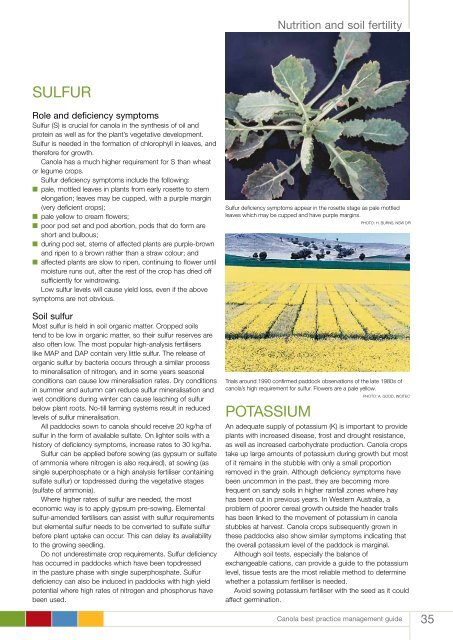best practice management guide for south-eastern Australia - Grains ...
best practice management guide for south-eastern Australia - Grains ...
best practice management guide for south-eastern Australia - Grains ...
Create successful ePaper yourself
Turn your PDF publications into a flip-book with our unique Google optimized e-Paper software.
Nutrition and soil fertility<br />
Sulfur<br />
Role and deficiency symptoms<br />
Sulfur (S) is crucial <strong>for</strong> canola in the synthesis of oil and<br />
protein as well as <strong>for</strong> the plant’s vegetative development.<br />
Sulfur is needed in the <strong>for</strong>mation of chlorophyll in leaves, and<br />
there<strong>for</strong>e <strong>for</strong> growth.<br />
Canola has a much higher requirement <strong>for</strong> S than wheat<br />
or legume crops.<br />
Sulfur deficiency symptoms include the following:<br />
n pale, mottled leaves in plants from early rosette to stem<br />
elongation; leaves may be cupped, with a purple margin<br />
(very deficient crops);<br />
n pale yellow to cream flowers;<br />
n poor pod set and pod abortion, pods that do <strong>for</strong>m are<br />
short and bulbous;<br />
n during pod set, stems of affected plants are purple-brown<br />
and ripen to a brown rather than a straw colour; and<br />
n affected plants are slow to ripen, continuing to flower until<br />
moisture runs out, after the rest of the crop has dried off<br />
sufficiently <strong>for</strong> windrowing.<br />
Low sulfur levels will cause yield loss, even if the above<br />
symptoms are not obvious.<br />
Soil sulfur<br />
Most sulfur is held in soil organic matter. Cropped soils<br />
tend to be low in organic matter, so their sulfur reserves are<br />
also often low. The most popular high-analysis fertilisers<br />
like MAP and DAP contain very little sulfur. The release of<br />
organic sulfur by bacteria occurs through a similar process<br />
to mineralisation of nitrogen, and in some years seasonal<br />
conditions can cause low mineralisation rates. Dry conditions<br />
in summer and autumn can reduce sulfur mineralisation and<br />
wet conditions during winter can cause leaching of sulfur<br />
below plant roots. No-till farming systems result in reduced<br />
levels of sulfur mineralisation.<br />
All paddocks sown to canola should receive 20 kg/ha of<br />
sulfur in the <strong>for</strong>m of available sulfate. On lighter soils with a<br />
history of deficiency symptoms, increase rates to 30 kg/ha.<br />
Sulfur can be applied be<strong>for</strong>e sowing (as gypsum or sulfate<br />
of ammonia where nitrogen is also required), at sowing (as<br />
single superphosphate or a high analysis fertiliser containing<br />
sulfate sulfur) or topdressed during the vegetative stages<br />
(sulfate of ammonia).<br />
Where higher rates of sulfur are needed, the most<br />
economic way is to apply gypsum pre-sowing. Elemental<br />
sulfur-amended fertilisers can assist with sulfur requirements<br />
but elemental sulfur needs to be converted to sulfate sulfur<br />
be<strong>for</strong>e plant uptake can occur. This can delay its availability<br />
to the growing seedling.<br />
Do not underestimate crop requirements. Sulfur deficiency<br />
has occurred in paddocks which have been topdressed<br />
in the pasture phase with single superphosphate. Sulfur<br />
deficiency can also be induced in paddocks with high yield<br />
potential where high rates of nitrogen and phosphorus have<br />
been used.<br />
Sulfur deficiency symptoms appear in the rosette stage as pale mottled<br />
leaves which may be cupped and have purple margins.<br />
<br />
Potassium<br />
Photo: H. Burns, NSW DPI<br />
Trials around 1990 confirmed paddock observations of the late 1980s of<br />
canola’s high requirement <strong>for</strong> sulfur. Flowers are a pale yellow.<br />
<br />
Photo: A. Good, Incitec<br />
An adequate supply of potassium (K) is important to provide<br />
plants with increased disease, frost and drought resistance,<br />
as well as increased carbohydrate production. Canola crops<br />
take up large amounts of potassium during growth but most<br />
of it remains in the stubble with only a small proportion<br />
removed in the grain. Although deficiency symptoms have<br />
been uncommon in the past, they are becoming more<br />
frequent on sandy soils in higher rainfall zones where hay<br />
has been cut in previous years. In Western <strong>Australia</strong>, a<br />
problem of poorer cereal growth outside the header trails<br />
has been linked to the movement of potassium in canola<br />
stubbles at harvest. Canola crops subsequently grown in<br />
these paddocks also show similar symptoms indicating that<br />
the overall potassium level of the paddock is marginal.<br />
Although soil tests, especially the balance of<br />
exchangeable cations, can provide a <strong>guide</strong> to the potassium<br />
level, tissue tests are the most reliable method to determine<br />
whether a potassium fertiliser is needed.<br />
Avoid sowing potassium fertiliser with the seed as it could<br />
affect germination.<br />
Canola <strong>best</strong> <strong>practice</strong> <strong>management</strong> <strong>guide</strong><br />
35

















